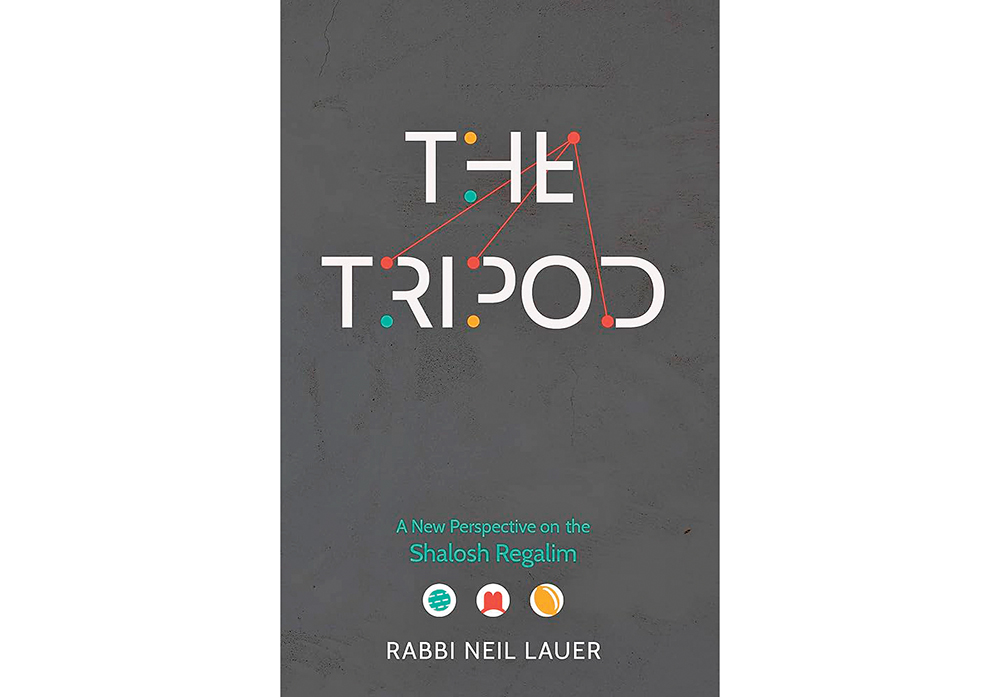
Highlighting: “The Tripod” by Rabbi Neil Lauer. Mosaica Press. 2022. 302 pages. ISBN-10: 1957579137.
Our Jewish year is punctuated by the shalosh regalim, with Pesach in early spring, Shavuot in late spring, and Sukkot in the fall. Jews were commanded to make a pilgrimage on these festivals to the Temple. While the shalosh regalim have other commonalities, such as intersecting with a significant agricultural or historical event, not all of the holidays fall neatly into these categories.
For example, Sukkot, commemorating God’s protection in the desert, does not mark a one time historical event and while Shavuot is traditionally understood as commemorating the giving of the Torah, this connection is not mentioned in the text of the Torah. Unlike Shavuot and Sukkot, Pesach does not mark a joyous ingathering of the harvest. It is not surprising then, that while we refer to these holidays as a group, we tend to celebrate each one as a separate entity.
“The Tripod” by Rabbi Neil Lauer comes to upend this understanding of these holidays. Instead of analyzing each festival separately, Rabbi Lauer suggests that “The Shalosh Regalim are a commemoration of our historic evolution into a nation of believers and the vehicle the Torah puts forth to transform us into, a nation of believers throughout the generations” (86). By failing to understand the connection between the shalosh regalim, “the tripod” of our relationship with God, we are missing a valuable opportunity for growth. As such, based on numerous sources from Tanach and commentaries that span the millennia, Rabbi Lauer demonstrates that Pesach teaches us God’s existence, Shavuot substantiates prophecy as the way that God communicates with humanity, and Sukkot symbolizes the divine providence in our daily lives. Each lesson develops from the one that precedes it.
Rabbi Lauer’s biggest innovation is that it is not only the messages of each holiday that build on each other, but also the method through which they are transmitted, which challenges us to broaden our relationship with God with increasing sophistication and intensity. In an ideal educational experience, the skills and content that are being taught build on past lessons. In Rabbi Lauer’s analysis, the shalosh regalim are the perfect pedagogical lesson plan. Pesach, exemplified by the Seder, is the first stage of our journey, focusing on exposure and direct instruction, and resulting in awareness but not internalization. The messier process of connecting to Shavuot, even without the unique mitzvot that define Pesach and Sukkot, allows for internalization. Finally, during Sukkot, we move outside to live in huts, allowing for a full integration of these messages into our lives.
Aside from being educationally sound, this framework explains various inconsistencies in the structure of the shalosh regalim, such as why the chagim do not follow a historical sequence. If this was the organizing principle, the order should have been Pesach, Sukkot and then Shavuot. While Rabbi Lauer offers numerous possibilities to solve this inconsistency, his main message is that history is only one aspect taught by the chagim. More fundamentally, the shalosh regalim are meant as spiritual education par excellence and this is the defining factor in the ordering of the chagim. Similarly, Rabbi Lauer uses this principle to explain Shavuot’s lack of mitzvot relating to Matan Torah. In his explanation, this ambiguity, which requires deeper investigation, is necessary to internalize its message.
Since a major part of the thesis is the importance of pedagogy for internalization, it is not surprising that Rabbi Lauer himself is thoughtful about the way that he conveys his ideas. Each chapter begins with a tidbit about his commute from the suburbs to the city via public transportation, which serves as a springboard to discuss the methodology of the festivals. The book is peppered with charts comparing many aspects of the festivals that Rabbi Lauer analyzes. The sources he quotes are footnoted throughout, enabling the reader to see the sources inside and making the book an especially good resource for teachers.
But one need not be a teacher to appreciate “The Tripod.” Every great teacher is a learner at heart. And as Rabbi Lauer compellingly demonstrates, learners we must be, to understand, internalize and integrate the messages that emerge from the chagim.
Shira Schiowitz teaches Tanach at SAR High School and is the rebbetzin of Congregation Shaare Tefillah.











